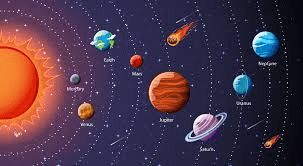How long does it take Earth to revolve around the sun?
365 days
Earth
Third planet from the sun, has oxygen and liquid water, Largest of inner planets, terrestrial and sustains life
Saturn
second largest planet and a gas giant. System of rings made of ice and rock
Define Asteroid
rocky or metallic objects that orbit the sun
What happens when the moon is waxing?
It appears to be getting larger – more light
How long does it take Earth to rotate on its axis?
24 hours
Venus
second closest planet to the sun and the hottest because the atmosphere does not allow the heat to escape. It is terrestrial and has many volcanoes and lava flows
Uranus
- Seventh planet and gas giant. Sideways planet as it is tilted. Green blue due to gases.
Telescopes
instruments that allow us to see objects larger and closer than they truly are. There are telescopes on the ground and in space.
What happens when the moon is waning?
It appears to be getting smaller – less light
Explain what causes tides and eclipses?
The moon having a gravitational pull on the Earth
Mercury
closest planet to the sun, smallest inner planet, terrestrial, very hot, almost no water and little air. Craters
Neptune
Farthest planet from sun and gas giant. Windy. Thirteen moons
Satellites
space stations in space that orbit another object and gather information for scientists.
Explain why during different phases of the moon it appears to be lit?
- the sun is reflecting light onto the moon.
Which planet is the hottest and why?
Venus:
because the atmosphere does not allow the heat to escape. It is terrestrial and has many volcanoes and lava flows.
Mars
fourth planet from the sun and terrestrial. Two small moons, non-active volcanoes. Much colder than Earth
Name the inner planets (terrestrial)
Mercury, Venus, Earth, Mars
Space probes
- unmanned spacecraft that leaves Earth’s orbit. Send pictures and data from space to Earth.
What is the sun?
It is a star
Draw the planets in order from the sun and name each planet.
Mercury, Venus, Earth, Mars, Asteroid Belt, Jupiter, Saturn, Uranus, Neptune

Jupiter
- Gas giant and largest of the outer planets. Has the Great Red Spot, 53 moons, bands of winds.
Name the outer planets (gaseous – Gas Giants)
Jupiter, Saturn, Uranus, Neptune
Rovers
robot explorers that record data on other planets
Why does the sun appear to be so large?
Because it is so close to Earth
Which planet is the largest of the inner planets?
Which planet is the largest of the outer planets?
Earth (inner)
Jupiter (outer)
Which planet has The Great Red Spot and the most moons?
Jupiter (53 moons)
Which planet is blue/green and why?
Uranus due to gases
Explain the difference between rotate and revolve (revolution)
- Rotate is to spin on an axis like the Earth spinning on its axis and revolve means to move around another object like Earth revolving or orbiting the sun.
- Draw the phases of the moon in the correct order: You will need to shade each circle and label each below the box
